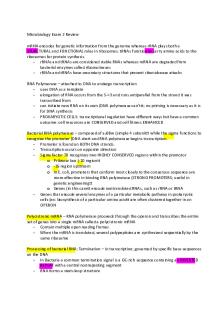Microbiology Lecture Exam 2 PDF

| Title | Microbiology Lecture Exam 2 |
|---|---|
| Course | General Microbiology |
| Institution | University of Central Arkansas |
| Pages | 4 |
| File Size | 74.4 KB |
| File Type | |
| Total Downloads | 22 |
| Total Views | 141 |
Summary
practice exam...
Description
Microbiology Lecture Exam 2 1. Most bacteria reproduce by a. Binary fission 2. The best way to prevent a viral infection is a. Vaccination 3. End products of the Krebs Cycle include a. ATP, NADH, CO2 4. The primary reason that stationary phase occurs is a. The organisms run out of nutrients 5. A strictly fermentative bacterium produces energy a. By glycolysis only 6. Figure 6.2 shows a typical bacterial growth curve with the y-axis indicating the log of the number of bacteria and the x-axis indicating time in culture. In the figure, which section (or sections) shows a growth phase where the number of cells dying equals the number of cells dividing? a. C 7. The most important and direct product of fermentation that benefits the fermenting cell is a. NAD+ 8. If you see a deer staggering in the woods, don’t kill it and eat it might have a. Chronic wasting disease 9. Which organism is NOT correctly matched to its energy source? a. Photoautotroph + CO2 10. Which of the following statements about anaerobic respiration is FALSE?
a. It involves the reduction of an organic final electron acceptor 11. What is the most acidic place in Figure 5.8? a. A 12. Symptoms due to most common viral infections (e.g. cold, flu) a. Are usually due to the immune system 13. A viroid is a(n) a. Infectious piece of RNA without a capsid 14. The mechanism whereby an enveloped virus leaves a host cell is celled a. Budding 15. The ultimate oxidation product of glucose is a. CO2 16. Which of the following is the best definition of fermentation? a. The partial oxidation of glucose with organic molecules serving as electron acceptors 17. An infectious protein is a a. Prion 18. The optimal growth temperature of a bacterium is most closely related to the optimal temperature for a. Functioning of enzymes 19. Which contains the most amount of energy? a. Glucose 20. Building blocks for biosynthesis come from a. The Core Pathways
21. In Figure 5.8, where is ATP produced? a. E 22. Which of the following statements about viruses is FALSE? a. Viruses use their own catabolic enzymes 23. Which of the following statements is NOT true of lysogeny? a. It causes lysis of host cells 24. Which of the following is the best definition of generation time? a. The length of time needed for a cell to divide 25. How is ATP generated in the reaction show in Figure 5.4? a. Substrate-level phosphorylation 26. In Figure 5.8, the path labeled “2” is the flow of a. Protons 27. How do all viruses differ from bacteria? a. Viruses are not composed of cells. 28. Which of the following is the best definition of oxidative phosphorylation? a. A proton gradient allows hydrogen ions to flow back into the cells through transmembrane protein channels, releasing energy that is used that is used to generate ATP. 29. Human and E. coli are a. Chemoheterotrophs 30. B vitamins are examples of a. Coenzymes 31. Superoxide
a. Is deadly to cells 32. Wild type E. coli does NOT require as a nutrient a. Essential metabolites 33. Life, as we know it, could not exist without enzymes because a. Even though the reactions would have occurred, they would have been far too slow for life to exist without the intervention of enzymes 34. One advantage of measuring growth by dilution and plating is a. That dilution and plating counts living cells 35. Which method of counting bacteria does not count the anaerobes? a. Spread plate method 36. Refer to Figure 5.8, in aerobic respiration, where is water found? a. D 37. The ONLY reason that strictly aerobic organism (such as humans) must breath in molecular oxygen is that a. The molecular oxygen acts as a final electron acceptor in respiration 38. In biological oxidations, what is typically removed from a molecule? a. Hydrogen atoms 39. Microorganisms found relatively deep below the surface of the Earth are most likely a. Chemoautotrophs 40. Which compound(s) is being reduced in the reaction shown in Figure 5.17? a. NAD+...
Similar Free PDFs

Microbiology Lecture Exam 2
- 4 Pages

Microbiology Exam 2 Review
- 14 Pages

Microbiology Exam 2 Study Guide
- 7 Pages

microbiology Exam
- 7 Pages

Microbiology first exam
- 7 Pages

Microbiology - Lecture notes - 1.17.12
- 183 Pages

Microbiology - Lecture notes 1
- 22 Pages

FOOD Microbiology EXAM
- 4 Pages

Microbiology Exam 3 (Autosaved)
- 16 Pages
Popular Institutions
- Tinajero National High School - Annex
- Politeknik Caltex Riau
- Yokohama City University
- SGT University
- University of Al-Qadisiyah
- Divine Word College of Vigan
- Techniek College Rotterdam
- Universidade de Santiago
- Universiti Teknologi MARA Cawangan Johor Kampus Pasir Gudang
- Poltekkes Kemenkes Yogyakarta
- Baguio City National High School
- Colegio san marcos
- preparatoria uno
- Centro de Bachillerato Tecnológico Industrial y de Servicios No. 107
- Dalian Maritime University
- Quang Trung Secondary School
- Colegio Tecnológico en Informática
- Corporación Regional de Educación Superior
- Grupo CEDVA
- Dar Al Uloom University
- Centro de Estudios Preuniversitarios de la Universidad Nacional de Ingeniería
- 上智大学
- Aakash International School, Nuna Majara
- San Felipe Neri Catholic School
- Kang Chiao International School - New Taipei City
- Misamis Occidental National High School
- Institución Educativa Escuela Normal Juan Ladrilleros
- Kolehiyo ng Pantukan
- Batanes State College
- Instituto Continental
- Sekolah Menengah Kejuruan Kesehatan Kaltara (Tarakan)
- Colegio de La Inmaculada Concepcion - Cebu






